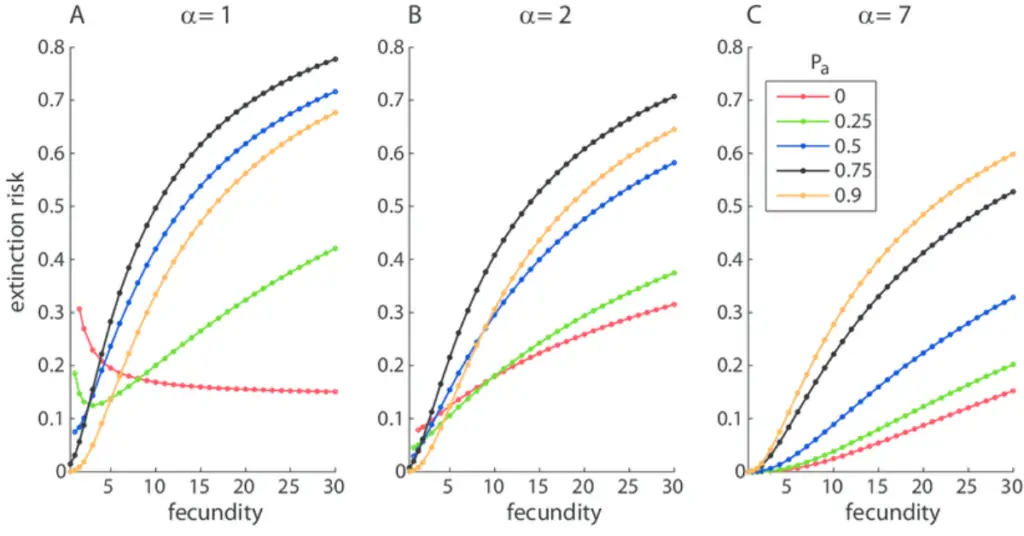Demographic stochasticity
Population stochasticity (also known as demographic change) refers to random variations in the demographic characteristics of a population (eg. sex ratios, birth rate, death rate), the cumulative effect of varying the fitness of individual organisms.
In any natural population founded by only a few individuals by definition start off with low genetic diversity, having lasting effects in the population through time. Some individuals will produce fewer offspring than average, while others will produce above average; some individuals will not produce offspring at all. Similarly, some individuals die earlier than average, while others live longer than average.
For large enough populations, average birth and death rates provide relatively stable descriptions of the main aspects of that population’s demographics. However, when the size of a population falls below a certain threshold, changes in the fitness of a small number of individuals can have a significant impact on the demographic parameters of overall populations, causing unpredictable fluctuations in population size and other characteristics.
Consider, for example, an isolated population of crocodiles with few females. As with many other reptiles, the sex ratios of crocodile offspring are determined by ambient temperature during incubation.
If, by chance, the population experiences two years of high temperatures, which favor male offspring, and little females die by chance, the entire male population may be doomed to extinction unless a few female crocodiles migrate from elsewhere.
Small population sizes or low densities can also disrupt social interactions between individuals, especially interactions that affect reproduction, which can make populations demographically unstable. This situation, called the Allee effect, can lead to a further decline in population size, population density, and population growth rate.
Obligate cooperative breeders, such as wild dogs (Lycaon pictus, EN), are particularly vulnerable to the Allee effect, because they need a certain number of individuals to protect their territory and obtain enough food for their offspring.
Allee effects could also prevent the impact on group-dwelling species that are not cooperative breeders: recalling the mantra “security in numbers”, Allee effects appear to prevent the recovery of locally rare sable antelope (Hippotragus niger, LC) populations in South Africa’s Kruger National Park, as reduced herd sizes increases their exposure to predation.
But even solitary species living in low densities are sensitive to Allee effects, because they may have difficulty finding mates once population density drops below a certain level.
The social systems of group living animals can easily be disrupted when their population size or density falls below a critical level.
Environmental stochasticity
Environmental stochasticity, the unpredictable variation of environmental conditions can cause dramatic fluctuations in population size over time and, therefore, greatly increase the risk of extinction.
Consider, for example, how the development rate of many insects is highly temperature-dependent.
In an average or warm year, young insects that hatch on time and feed well may turn out to be unfit adults that produce many juveniles, while unusually cold years could reduce hatching success and larval activity, which could also reduce adult fitness.
Thus, very unfavorable conditions in one year can lead to a dramatic drop in the population, or even push a species to extinction if conditions persist in subsequent years across its range.
The increased risk of extinction due to environmental stochasticity also applies to natural disasters that may occur at unpredictable intervals (eg.drought, storms, earthquakes and fires). Species subject to range limits are particularly vulnerable to this type of threat.
For example, the biodiversity that lives in and around several African crater lakes is vulnerable to a rather unique natural phenomenon called “lake burping”. The volcanic chambers under some of these lakes are rich in CO2. Small amounts of CO2 can sometimes (or constantly, in some cases) seep through the bottom of the lake into the surrounding water.
Because these lakes are thermally stratified, layers of cold, dense water settle near the bottom when they are warm, less dense water floats upwards: CO2-saturated water stays near the bottom of the lake.
However, when a geological disturbance occurs, such as a landslide or earthquake, huge amounts of CO2 can suddenly be released, saturating the water to higher levels with CO2 (killing fish and other oxygen-dependent species in the process), before displacing breathable surface air in and around the lake.
In 1986, one such CO2 eruption killed 1,800 people and 3,500 head of cattle near Lake Nyos in Cameroon. Some scientists fear that increased deforestation (which could trigger erosion and landslides) and hydraulic fracturing (which could trigger earthquakes) could trigger similar events in other volcanic lakes in the region.
Environmental stochasticity tends to increase the probability of extinction more than population stochasticity. As noted, this is especially true for small populations and limited species.

Erzsebet Frey (Eli Frey) is an ecologist and online entrepreneur with a Master of Science in Ecology from the University of Belgrade. Originally from Serbia, she has lived in Sri Lanka since 2017. Eli has worked internationally in countries like Oman, Brazil, Germany, and Sri Lanka. In 2018, she expanded into SEO and blogging, completing courses from UC Davis and Edinburgh. Eli has founded multiple websites focused on biology, ecology, environmental science, sustainable and simple living, and outdoor activities. She enjoys creating nature and simple living videos on YouTube and participates in speleology, diving, and hiking.

